|
|
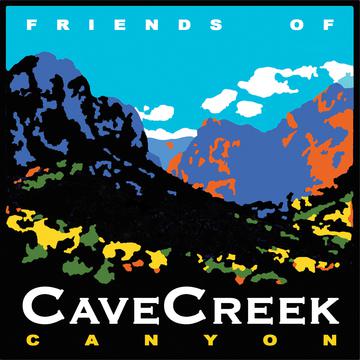 To Cave Creek
Canyon Friends
|
|
Our Mission is to inspire appreciation and understanding of the beauty, biodiversity and legacy of Cave Creek Canyon through volunteer work and outreach programs.
|
|
Eared Quetzal Story Revisited
By Steve Wolfe [Story and photos]
Our Eared Quetzal saga may be continuing for a long time to come. Experts here familiar with EQs in Mexico have determined the Barfoot Quetzal is most likely a female. And with the June immature male and recent reports of a possible male being seen at South Fork and two males at Rucker Canyon, it's not too far-fetched to think there may be more in the Chiricahuas and perhaps even little Eared Quetzals in our future.
In the June FOCCC email there was an article by Helen Snyder about the very rare Eared Quetzal that was being seen:
"The Avian Blue Moon By Helen Snyder
When you hear that something happens "Once in a blue moon", it means rarely. And something much rarer than a 'blue moon' appeared in Portal on June 7 when Peg Abbott and I finally identified the bird that was the source of some strange calls we'd been hearing: it was a flashy, loud and colorful Eared Quetzal, ........" [Read the article]
"Let's hope it returns in late summer to a remote cool patch of conifers, this time to sing its triplet territorial song to its mate."
|
SOUTH FORK CAVE CREEK DAY USE PROJECT
The Draft Environmental Assessment of the Project
Is Expected soon
As we told you earlier, Friends of Cave Creek Canyon has been working with the Forest Service for the past 18 months on a plan to replace the picnic area, bathroom, and benches rendered inaccessible by the flood of 2014, and later removed. The Forest Service has been developing a Draft Environmental Assessment of a plan to meet the needs of South Fork, which will soon be available for public comment.
The FOCCC website now includes a page dedicated to the South Fork Project. It contains: - information on the history of South Fork development
- progress made between 2015-2020 to identify needs to repair Hurricane Odile damage
- the NEPA Process to address needs
- progress on the NEPA process in 2020
- FOCCC and Community Input on Solutions, including a summary of the March 9, 2020, meeting with the Forest Service and the community, and contributions from community members.
- When the Draft Environmental Assessment is published by the Forest Service, a link will be posted on this webpage.
WE WILL SEND AN ADDITIONAL EMAIL UPON THE RELEASE OF THE DRAFT ENVIRONMENTAL ASSESSMENT.
|
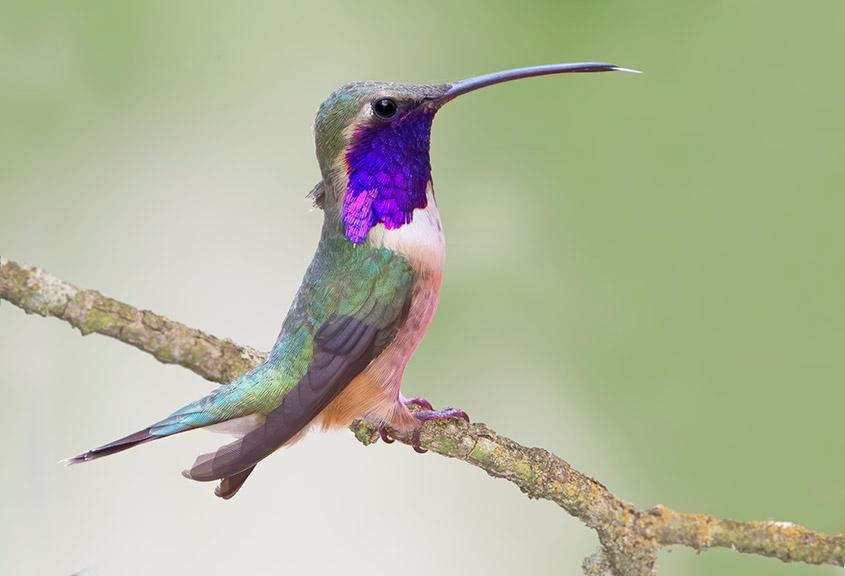
Lucifer Hummingbird [Photo By Mark Chappell]
ar
|
|
Lucifer Hummingbirds
By Jackie Lewis
Visit with her and the hummingbirds at
The Lucifer Hummingbird (Calothorax lucifer), belongs to a group of hummingbird species called "sheartails," named for their deeply forked, narrow tail. Typically considered a rare bird in the Chiricahuas (defined by Rick Taylor as "probably single or more birds occur annually at least once, but are not necessarily observed") we have seen an "explosion" of the numbers of birds seen this year. Rick Taylor reported 7 in Whitetail Canyon at his feeders at the same time. The sightings are also up all over the southern portion of Arizona. It has been a pleasure being able to share this bird with yard visitors.
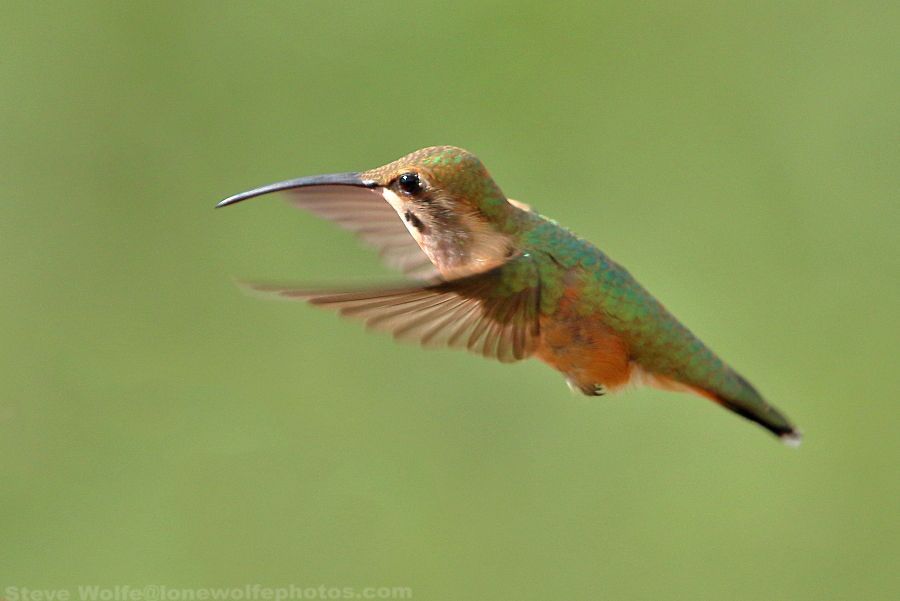 This spring in Paradise we had 3 identifiable Lucifer males and 1 female. They visited the feeders for close to 6 weeks. One of the males was banded on Easter Sunday 2019 by the Hummingbird Monitoring Network. Enough of his band number, M66602, was visible to identify him. He returned this fall and at least 2, possibly 3 other males have been identified by gorget patterns. A female has also been in this fall. I was hoping to see juveniles but so far have not. [Photo by Steve Wolfe] This spring in Paradise we had 3 identifiable Lucifer males and 1 female. They visited the feeders for close to 6 weeks. One of the males was banded on Easter Sunday 2019 by the Hummingbird Monitoring Network. Enough of his band number, M66602, was visible to identify him. He returned this fall and at least 2, possibly 3 other males have been identified by gorget patterns. A female has also been in this fall. I was hoping to see juveniles but so far have not. [Photo by Steve Wolfe]
I have noticed that the Lucifer Hummingbirds tend to visit the feeders more regularly in the afternoon and evening. This pattern was historically seen over at Mary Jo Ballator's in Sierra Vista. So, if you are on a tight timeline and don't want to wait as long at the feeders, an afternoon visit is in order. If you have time, come in any time during the day. Other species will keep you entertained while you wait.
|
|
Klaus Fire
Report as of Thursday August 20, 2020
The Klaus Fire is located on the Douglas Ranger District on the Coronado National Forest. The fire was started by lightning on August 10, 2020. It is located approximately 11 miles southwest of Portal, AZ. The fire moved through grass and brush vegetation in steep, rugged terrain. Resources assigned included two crews, four engines, two dozers, one medic team, one Rapid Extraction Module (REM Team), one type-three helicopter, and miscellaneous overhead.
As of August 20, the fire was 100% contained and had consumed over 4,800 acres. Thank you US Forest Service!
|
|
2020 Portal Butterfly Count Results
Lori Conrad
As you may remember from the last FOCCC newsletter, we held our annual butterfly count here in the Portal area on Sunday, August 2nd. We had a total of 10 participants this year, in 3 groups to better cover more areas.
We tallied a total of 51 species, which isn't too bad considering how little nectar there was. We were fortunate enough to have had access to a couple of really productive neighborhood gardens, plus the gardens at the Visitor Center, which are maintained by a wonderful team of volunteers. Blooms elsewhere were pretty much non-existent in the lower canyon. Our team in the high country (Barfoot, Rustler, Long Park, etc.) fared a bit better, finding more nectar sources up at the higher elevations.
High numbers of Dull Firetips were noted, a real large, showy member of the skipper family, with 761 individuals! Seemed like every pink thistle bloom and every blooming agave had at least 4-6 on it, especially up at the East Turkey Creek area.
Dull Firetips
Here are a few more butterfly highlights from that day:
  Common Buckeye Common Sootywing Common Buckeye Common Sootywing
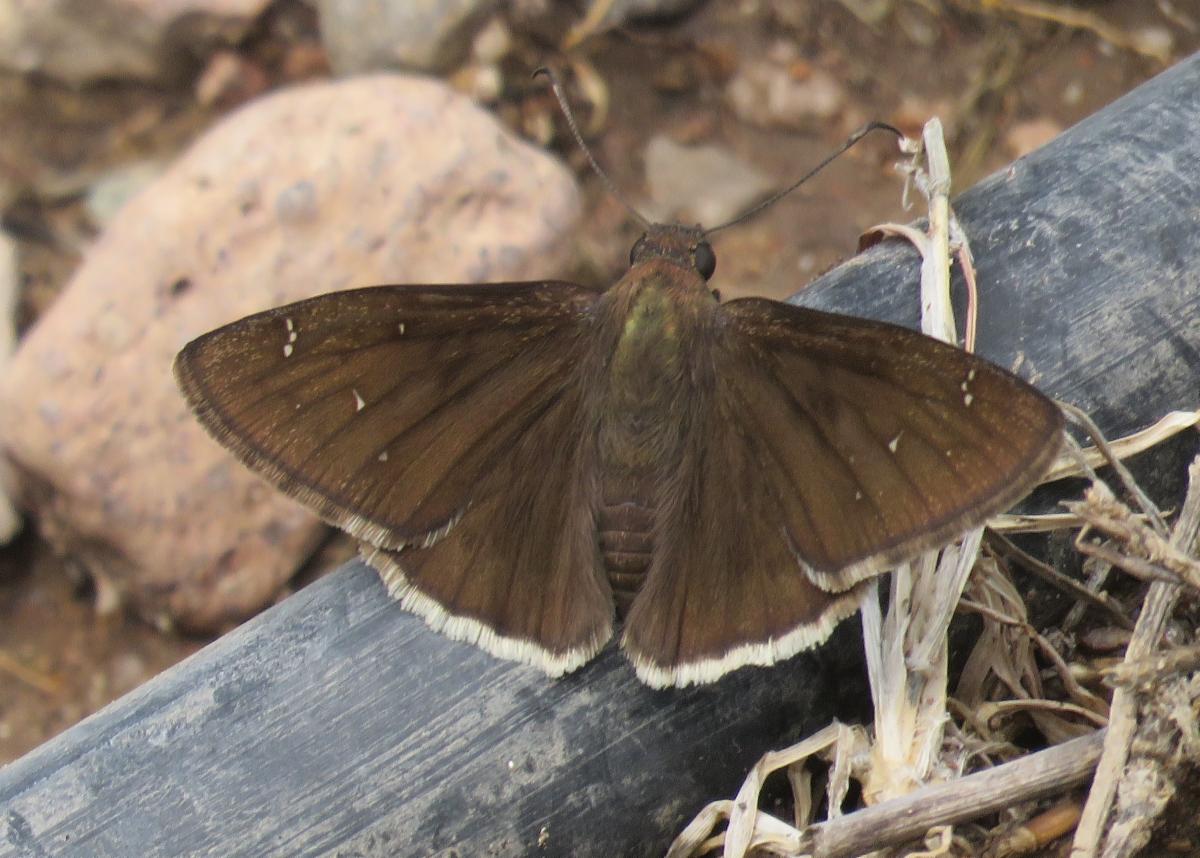  Drusius Cloudywing is another fairly large Black Swallowtail Drusius Cloudywing is another fairly large Black Swallowtail
member of the skipper family
|
Monsoon in August?
There has been almost no rainfall in August, which is normally a monsoon-affected, wet month. It has been one of the hottest months in many resident's memories. We did receive good amounts of rain in July, but need a lot more.
This picture by Steve Wolfe is representative of many evenings this August: lightning, thunder and no rain!
The monsoon season brings out certain insects. Howard Topoff provided these examples:
Giant Mesquite Bug - Immature
During summer here in southeastern Arizona, you can find these beautiful red and white bugs nibbling on the foliage of mesquite. These colorful insects are true bugs (Hemiptera) and are the immature, wingless nymphs of the Giant Mesquite Bug (Thasus neocalifornicus).
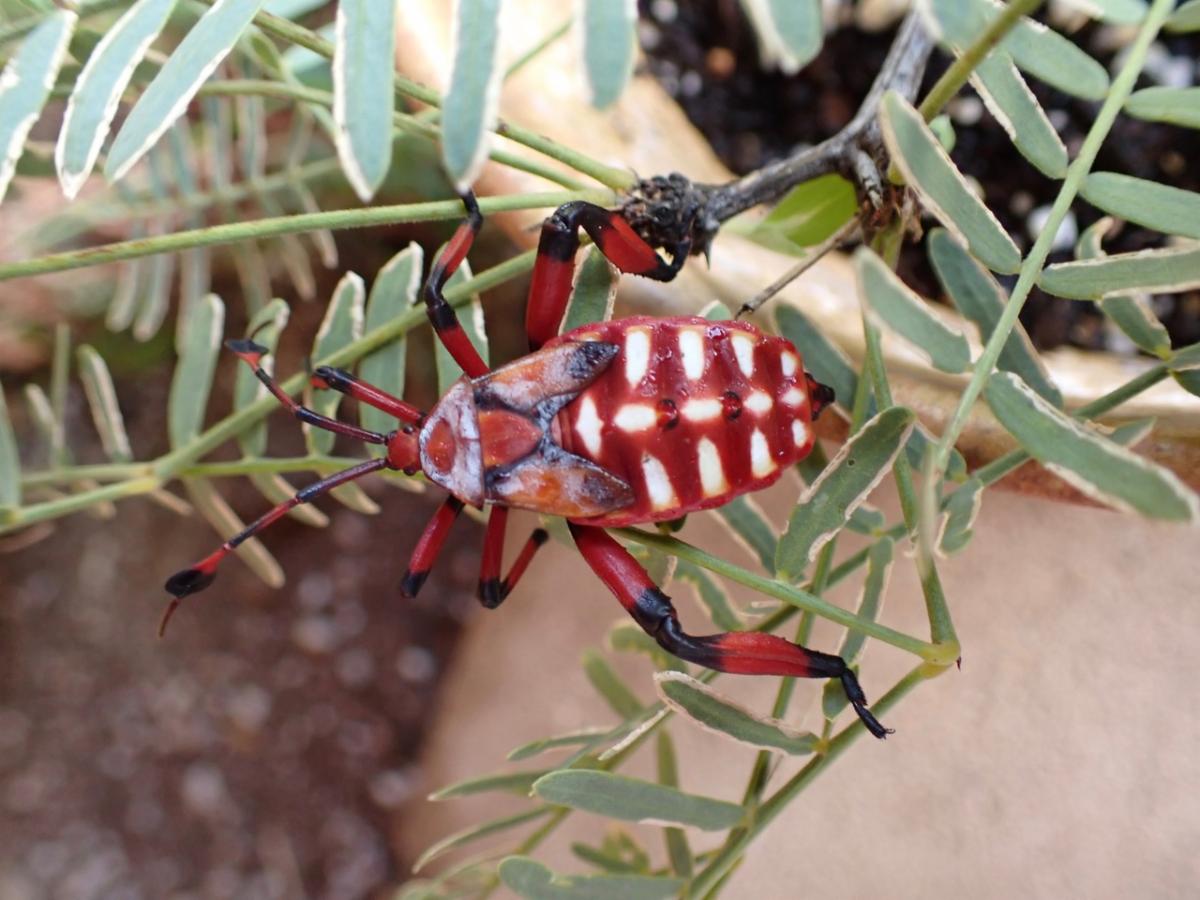 Easy to identify, these nymphs are striped red and white, have plump, red a nd black legs, and large, red and black antennae with a flattened sensory disk just below the terminal segment.Those bright colors make quite a "statement" as they are a form of aposematic coloration meant to warn potential predators that they are not good to eat. If attacked, the flightless nymphs can produce a stinky secretion to repel any predators not already warned off by their bright colors.  Giant Mesquite Bug - Adult Giant Mesquite Bug - AdultThe much less colorful adult Giant Mesquite Bugs have wings and are capable of flight. The adults are slightly over an inch long and have black wings with yellow veins and red and black-banded antennae and legs. The sexes are easily distinguished because male Giant Mesquite Bugs like this one have greatly enlarged femurs on their hind legs.
Chrysina gloriosa - the Glorious Scarab
This is everyone's favorite summer beetle. Chrysina gloriosa is found from Texas to Arizona and into Northern Mexico. Its habitat is high elevation juniper forests and juniper leaves are its food. Easily camouflaged by its green and silver coloration during the day, these nocturnal scarab beetles are attracted to all manner of lights at night. "Chrysina" is Greek for gold, and they do look like something of value. Wing cases of eaten Chrysina are frequently found on the ground, so it is doubtful that their green and gold pattern are warning colors.
|
|
Hike & Trail Maintenance
Hike by Elaine
Four of us met on August 6th to hike up the Greenhouse trail, which we haven't done in a while.
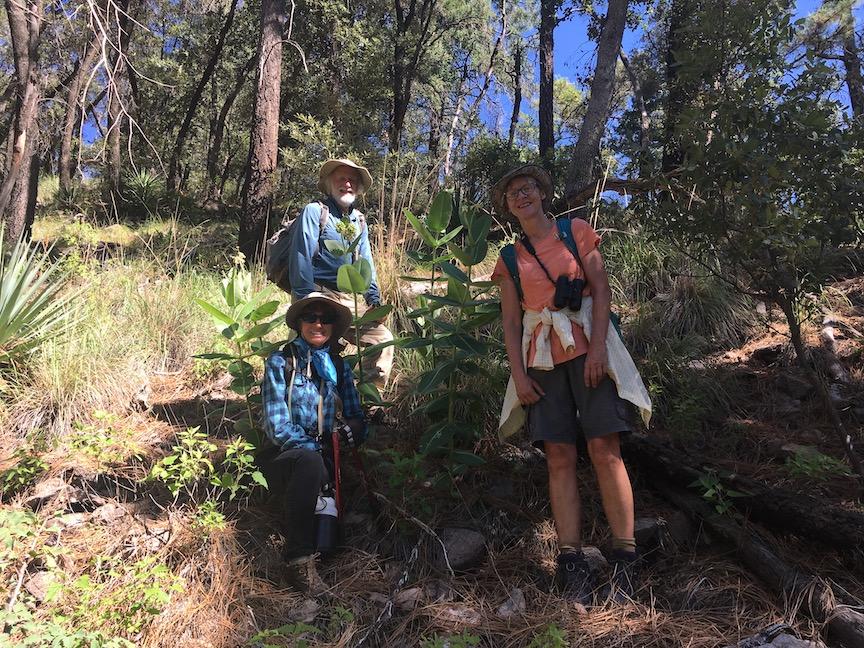 We were able to drive all the way to the trailhead with good clearance and 4-wheel drive. There were a number of large Lemmon's milkweed (Asclepias lemmoni) blooming alongside the road. Greenhouse is such a beautiful canyon with huge, tall conifers and lots of nice understory trees and shrubs.
With the recent rain it was verdant and the creek was flowing, but low.
We had some loppers and small saws to cut back some of the brush making it easier for future trail work - and future hikes. Also kept track (for the sawyers) of trees that had fallen across the trail. There was a lot of thorny Ceanothus, Locust and raspberries to cut back - only a few berries left to eat, but there were a couple of fruiting Elderberry trees - delicious!
Our group climbed up the switchbacks to the ridge overlooking Winn Falls, and lunched (napped?) there before climbing up toward upper Cima creek. We had hoped to reach Cima cabin and the crest, but we encountered a mess of fallen trees and the rain became heavier, so we decided to turn around. It was about 5 miles round trip, with roughly 2000 foot elevation gain.
hike report and photos from Elaine
Trail Maintenance by Rolf
Saturday, August 15 Jonathan, Dirk and I cleared a biggish log from the Barfoot Lookout Trail, not too far from the trailhead at Barfoot Park. I took the attached pictures there. We then had lunch and moved on to the Fly Peak Trail, clearing 8 logs there, making for easy access to the summit from the north, which is the way most people go.
|
|
Photos from around Portal
[By Peg Abbott]
 Monsoon Sunrise [Steve Wolfe]
Roadrunner by Fred Espenak Yucca by Alice Wakefield
Millipedes by Ray Mendez
[Millipede by Wyatt Mendez]
A Natural moment from our backyard: Now that the rains are going strong in our area we will start to see lots of neighbors crossing the road. In the evening two of the most common are male tarantulas (walking a bit like the old Frankenstein movie character with his arms sticking straight out) and millipedes, the little black critters that look like a line on the road. Both have interesting stories but what gave me the impetus to write about the millipedes is an incredible picture Wyatt took of one the other day.
Millipedes, not to be confused with centipedes, have two sets of legs per section, whereas centipedes only have one set of legs per section. They usually eat decomposing plant materials and do not bite. However some, the polydesmid millipedes, can spray hydrogen cyanide as a defense. I love watching them walk across large ant nests in the desert where the ants totally ignore them. In our region they have several predators among them our native glow-worm or railroad-worms (Phengodidae) which often eat them from the rear end, perhaps to avoid the cyanide.
Some millipedes are round, some flat in appearance with small protrusions along the edge of the exoskeleton. Some have lovely colors, some are shiny but most are dull colored. They make great pets and are easy to keep. Just don't put them in your mouth or rub your eyes after playing with them. As with any pet a bit of pre-planning and reading makes all the difference to your success as a millipede keeper. Have fun...
|
|
Barfoot Park
Mexican Chickadee - only seen at higher elevations in the Chiricahua Mountains. Above pictures by Peg Abbott
Steve Wolfe's Pictures From Barfoot Park
Male Hermit Warbler Female
Townsend's Warbler Red-faced Warbler
Grace's Warbler Wilson's Warbler
|
|
Stories of the Past
EXCERPTS FROM THE CHIRICAHUA BULLSHEET
The Chiricahua Bullsheet, an entertaining and highly opinionated newsletter and journal of local history written by Carson Morrow.
Courtesy of Dick Zweifel, former long time resident of Paradise and Portal. Dick was very active in the community and a supporter of many local organizations, in addition to being a herpetologist and butterfly expert. He passed away last year. Thank you Dick for all you did.
More Stores of Galleyville:
There are no houses or even any walls still standing, the only indication of past habitations are graded out places where the wooden structures stood and mounds of dirt where the Adobe ones tumbled down. The old dance hall was still in pretty good condition until about 1908, when it caught fire and burned all the wood work, the adobe walls have completely weathered away.
An old fellow by the name of Mills was living in it at the time it burned. He was the last resident but he had moved in quite some time after the town had been abandoned.
No census was ever taken but judging from old stories and from the building sites there were probably about one hundred fifty regular residents, supplemented from time to time by hundreds of visitors, good and bad, mostly bad.
Billy the Kid; Big Foot Wallace; Curly Bill Brosius and his numerous followers were frequently there. It has been said that Big Foot Wallace shot Curly Bill through the neck one night in a saloon brawl. Bill didn't die from it, but Big Foot might have. There doesn't seem to be any record of him ever being seen after he hurriedly left town the night Curly was shot.
Many years later Bill Sanders found the skeleton of a man in a crevice in the rocks on a little hill just North of Grapevine Spring, an old rotted saddle was on top of the skeleton and Bill thinks this might have been the remains of Big Foot, he probably having been Dry Gulched by some of Curly's henchmen.
There have been a lot of Blood and thunder stories told and written about Galeyville, but if they are true, you can come to one of two conclusions, either those people practiced cannibalism or they were the worlds poorest shots as the graveyard had exactly three graves after the smoke had cleared and the population had departed entirely. One of those was reportedly occupied by one of Curly Bill's men who Parson Chenowth killed with a blow from his fist, another was a stranger who was found dead on the street one morning with his head bashed in by a pick handle in the hands of a party or parties unknown; the third died of Pneumonia.
There is no one alive today that was in Galeyville at that time, so the chances of verifying this is nil, but the fact that there are only five graves is indisputable and several of we old Paradise residents know for sure that two of them are occupied by the bodies of people who died in Paradise before the present graveyard there was established.
One of them was a little boy about ten years of age by the name of Willie Shipman and the other was a miner whose name is not remembered.
|
Visitor Information Center Will Be Partially Open Labor Day Weekend 9 am - 3 pm Afterwards To Be Determined
Forest Service established campgrounds were closed on 3/23/20. Herb Martyr and Rustler Park Campgrounds are now open. Sunny Flat, Idlewilde and Stewart Campgrounds remain closed through at least August, possibly opening sometime in the Fall.
Dispersed camping is allowed in higher elevations, above Southwestern Research Station. The forest remains open. Call (520) 558-2221 or (520) 388-8436 for Information
|
|
|
|
FOCCC 2020 Officers and Board
Reed Peters President Other Board Members
Sheri Ashley Vice President Bob Ashley
Mike Williams Vice President
Alan Craig
Rick Beno
Treasurer
Rene Donaldson
|
|

Friends Of Cave Creek Canyon
PO Box 16126
Portal, Arizona 85632
Visit Our Website
|
Thanks to our "Sustainer's Circle" and Lifetime Members
for their generous support:
Kirby Alguire, Tom Arny, Bob and Bettina Arrigoni, Susan Dalby & Eskild Peterson, Stephen Durkovich, L. Syrene Forsman, Mary George, Bill and Sally Hague, Paul Hirt and Linda Jakse, Fritz and Gayle Jandry, Don Hollister, Claudia Kirscher, Mike Leuthold, Barbara Lounsbery, Patrick McNamara, John and Karin McQuillan, Barbara and Pete Miller, Patricia Parran, Cecilia Raak, Tom Roseman and Paula Baldwin, Delia Scholes and Ed Newbold, John and Linda Sumner, Jeff and Alice Wakefield, and Bob and Sherry Zoellick.
|
|
Please support our Business Members who have given generously to Friends Of Cave Creek Canyon. Without their assistance, we would be hard pressed to accomplish our goals. Click on their names to check out their websites.
Business Memberships start at just $50.00!
|
|
|
|
|